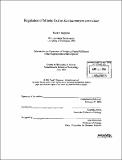| dc.contributor.advisor | Angelika Amon. | en_US |
| dc.contributor.author | Stegmeier, Frank P. (Frank Peter), 1975- | en_US |
| dc.contributor.other | Massachusetts Institute of Technology. Dept. of Biology. | en_US |
| dc.date.accessioned | 2006-03-29T18:27:49Z | |
| dc.date.available | 2006-03-29T18:27:49Z | |
| dc.date.copyright | 2004 | en_US |
| dc.date.issued | 2004 | en_US |
| dc.identifier.uri | http://hdl.handle.net/1721.1/32252 | |
| dc.description | Thesis (Ph. D.)--Massachusetts Institute of Technology, Dept. of Biology, 2004. | en_US |
| dc.description | Includes bibliographical references. | en_US |
| dc.description.abstract | Successful cell division requires the coordination of several mitotic processes, such as chromosome segregation, spindle disassembly, and cytokinesis. Progression into mitosis is driven by mitotic cyclin dependent kinase (CDKs) activity. In order for cells to exit from mitosis, mitotic CDKs must be inactivated. In the budding yeast, Saccharomyces cerevisiae, the Cdcl4 phosphatase promotes mitotic exit by antagonizing mitotic CDKs. The activation of this phosphatase is controlled by the mitotic exit network (MEN), a Ras-like signaling cascade essential for exit from mitosis. The work presented herein describes the identification and characterization of a novel regulatory pathway, termed the Cdc fourteen early anaphase release (FEAR) network, which regulates the activation of Cdcl4 during early anaphase. I found that at the onset of anaphase, the FEAR network initiates the release of Cdc 14 from its inhibitor. During later stages of anaphase, the MEN promotes further release of Cdc14 and maintains the phosphatase in its released state. The FEAR network is comprised of the separase Espl, the polo-kinase Cdc5, the kinetochore protein Slk19, the replication fork block protein Fobl, and the small nuclear proteins Spol2 and Bnsl. Genetic epistasis analyses revealed that the FEAR network consists of at least two branches. ESPI and SLK19 function in parallel to SP012 and FOBI. I then characterized the Spol2-Fobl branch in detail. My results suggest that Fobl prevents Cdc14 activation prior to anaphase. | en_US |
| dc.description.abstract | (cont.) pol2, in turn, promotes the activation of Cdcl4 during early anaphase at least in part by antagonizing Fob function. The finding that two important regulators of sister-chromatid separation, the separase Espl and the polo-kinase Cdc5, also promote the activation of Cdc 14 provides a molecular explanation as to how cells ensure that exit from mitosis does not occur prior to the onset of sister-chromatid separation. | en_US |
| dc.description.statementofresponsibility | by Frank P. Stegmeier. | en_US |
| dc.format.extent | 239 leaves | en_US |
| dc.format.extent | 8881112 bytes | |
| dc.format.extent | 8877562 bytes | |
| dc.format.mimetype | application/pdf | |
| dc.format.mimetype | application/pdf | |
| dc.language.iso | eng | en_US |
| dc.publisher | Massachusetts Institute of Technology | en_US |
| dc.rights | M.I.T. theses are protected by copyright. They may be viewed from this source for any purpose, but reproduction or distribution in any format is prohibited without written permission. See provided URL for inquiries about permission. | en_US |
| dc.rights.uri | http://dspace.mit.edu/handle/1721.1/7582 | |
| dc.subject | Biology. | en_US |
| dc.title | Regulation of mitotic exit in Saccharomyces cerevisiae | en_US |
| dc.type | Thesis | en_US |
| dc.description.degree | Ph.D. | en_US |
| dc.contributor.department | Massachusetts Institute of Technology. Department of Biology | |
| dc.identifier.oclc | 56023552 | en_US |
